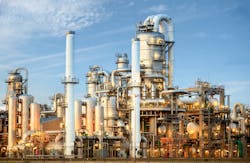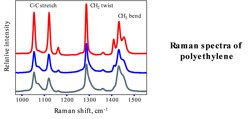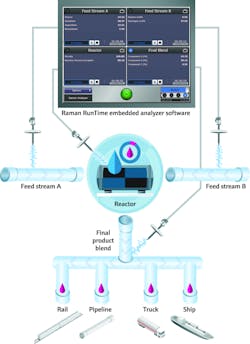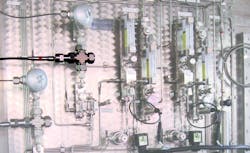Analyzers: PATs Promise Enhanced Efficiency And Safety
In many process industries, the increased capability of optical technology—combined with its mechanical simplicity—is driving a migration from complex and offline traditional analytical methods toward more robust online and inline optical techniques. The chemical industry is no exception.
Raman and tunable diode laser absorption spectroscopies (TDLAS) are two primary process analytical technologies (PATs) used for measuring chemical composition and concentration. Both are capable of measuring gas-phase hydrocarbons and diatomics, and Raman spectroscopy can also be used to quantify inorganic and specialty chemicals in their liquid or solid phases.
Today, PATs are often used to close control loops with near real-time, highly accurate measurements, improving upon lab-based analyses and their inherent lag time. These online or inline measurements empower operators to run their processes closer to target setpoints, increase efficiency and product yield, minimize losses, and maximize product quality. They can also help improve plant safety by providing personnel with a greater awareness of process conditions. Additionally, these types of autonomous measurements do not normally require human intervention, further reducing the risk of exposure to hazardous chemicals.
TDLAS and Raman spectroscopy provide valuable information, however, as with any technology, users must understand the limitations of these instruments to utilize them correctly.
Issues With Existing Approaches
Keeping pace in the chemical industry is difficult, given increasing market globalization, tightening industry regulations and growing competition. Processors have the tall order of ensuring product consistency, maintaining safety compliance, and improving sustainability, while attempting to drive production as efficiently as possible for maximum profitability.
Adding to these challenges, many chemical plants are burdened by aging measurement equipment, such as gas chromatography, making it difficult to remain competitive. Additionally, a higher degree of sample conditioning requirements and mechanical issues can reduce analyzer and plant uptime, resulting in diminished production performance at best, and poor quality and safety issues at worst.
These older measurement technologies can be slower, less accurate and require more maintenance than their modern optical successors. Additional difficulties of these traditional analytical techniques include:
- extensive sample conditioning required via sample handling systems.
- time-intensive measurement cycles, resulting in significant sample analysis times.
- high ongoing cost of consumables and utilities.
- safety risks associated with manual extractive sampling and laboratory analysis.
- low adaptability to process changes.
- complex installation configurations.
- large and expensive physical footprints, often requiring an analyzer shelter.
Principles Of Measurement
TDLAS and Raman spectroscopy are both capable of measuring chemical concentrations from percentage to ppm levels in process feed streams, reactors and final product streams. Infrared TDLAS is the most commonly used laser-based absorption technique for quantitative assessment of species in the gas phase.
A TDLAS instrument consists of a tunable diode laser light source, transmitting optics, an absorbing medium, receiving optics and a detector. The emission wavelength of the tunable diode laser is tuned over the specific absorption lines of a species in the gas within the laser beam path, creating a reduction of the measured signal intensity due to absorption. A photodiode detects the reduction, which is then used to determine gas concentration.Raman spectroscopy is a non-destructive technique for measuring the chemical and physical properties of a sample by excitation with a visible or near-infrared laser. As this light interacts with molecular vibrations in the sample, it becomes inelastically scattered. When the energies of the resulting scattered photons are plotted as a spectrum, subtle changes in light wavelengths can be observed that are specific to each molecular vibration. Most incident-scattered light shares the wavelength of the laser source, but the small percentage that differs is used to identify and quantify the sample chemistry.
Raman spectroscopy therefore generates a “molecular fingerprint” used to identify, quantify and monitor changes in the molecular makeup of the sample (Figure 1). Raman spectroscopic analysis provides sample information regarding:
- chemical composition and concentration.
- phase and polymorphism.
- intrinsic stress and strain properties.
Originally developed and practiced in academic laboratory settings in the 1920s, significant advances in the technology have been made over time. These include instrumentation and user-friendly interface enhancements, making the technology more practical for online and inline industrial applications since the 1990s.
Modern PAT Benefits
Compared to its predecessors, TDLAS and Raman instrumentation is easy and economical to install, operate, and maintain. Because many industrial Raman instruments are equipped with multiple probes for insertion into different process streams, a single transmitter can often replace several process gas chromatographs (GCs), which each need their own process penetration and sample conditioning system. This can save shelter space, and lower operational expenditures by eliminating intensive GC and sample conditioning system maintenance requirements, which include mechanical components that wear out over time.
Accuracy and reliability are of the utmost importance for effective process control, and the measurements must be unaffected by sample conditions. It is often said that approximately 80% of process analyzer failures occur due to the sample conditioning system, rather than the analyzer technology itself. As trends in the miniaturization of electronics and reduction in instrumentation size continue, it becomes more critical for analyzers to tolerate outdoor environments. With this comes a greater probability of connecting PAT instrumentation directly to the process, thereby eliminating downtime due to issues related to a sample conditioning system.
Modern PAT instrumentation provides real-time and in-situ measurements far more quickly than offline techniques, often with greater accuracy and reproducibility, and enhanced safety. In some applications, these technologies are used to improve safety within a chemical plant by taking measurements autonomously in ISO 9001:2015 hazardous areas, reducing the risk of human exposure to dangerous chemicals.
Raman spectroscopy, in particular, is useful for:
- measuring the composition and concentration of feed streams.
- monitoring reaction progress in continuous and batch reactors.
- detecting the endpoint of a reaction.
- determining the quality of end products.
Processors can leverage modern PATs to optimize product quality by tuning their processes to create optimal reaction conditions, for example when producing polymers. Additionally, the financial impact of reduced product giveaway and final product off-spec is substantial, often resulting in an ROI that can be measured in days or weeks, not years.
Application Considerations
While these modern optical techniques save processors time, money and maintenance, there are process- and environmental-specific factors to consider when specifying the ideal instrumentation for an application. For example, some process chemistries exhibit optical fluorescence, which can create a broadband saturation, hindering the ability to adequately measure Raman bands. Using a laser source further away from the visible region of the spectrum can sometimes alleviate this issue.
Additionally, measuring trace components below 100 ppm is difficult to achieve using Raman, and is better left to alternative methodologies. Components that exhibit weak absorbance due to low polarizability of outer electrons are also better candidates for other measuring techniques, such as mid- or near-infrared, which are complimentary to Raman.
Plants must also consider safety issues when installing analyzers with lasers in flammable environments. If the entire instrument resides in a hazardous zone requiring an ATEX or IECEx rating, typical low-voltage components — most often 24V DC — and cabinet air purging should be used to reduce the risk of electrical sparks. To circumvent the cost and complexity of these additional safety features, it is common to place the analyzer in a general-purpose room, frequently mounted in a computer rack, away from the sensor.
However, fiber optic cables reaching into hazardous zones still pose a safety risk. For example, when a fiber optic cable is damaged and the fiber becomes exposed, it can transmit the energy of laser light into the surrounding environment. Conceivably, this energy can heat objects to a temperature causing the ignition of flammable gases in the area.
One way to prevent this from happening is to include a wire loop inside the jacket of fiber optic cables that, when broken, opens an interlock to the laser, causing it to shut down. The shutdown typically takes place in under 20 ms. Additionally, limiting the power of lasers to 35mW or less can help avoid overheating process samples during routine analysis, even those unexposed to the open atmosphere.
DigitalizationAligning with greater industry trends, advances in PATs are also contributing to an increase in chemical plant digitalization. These modern instruments achieve this by creating continuous data streams, then feeding the information to host systems. For example, real-time control systems act upon the process variable measurement to perform closed-loop control. Asset management systems and process historians, which can be either on-premises or cloud-based, store process variables and other data — including physical and chemical properties — for analysis.
Diagnostic and analyzer health data also is provided for use by maintenance and operations teams, enabling them to spot developing instrumentation issues and preemptively perform predictive maintenance. For example, by monitoring the temperature of the internal electronics enclosure, maintenance teams can determine the expected lifetime of circuit boards exposed to extreme environmental conditions. Or, by monitoring the signal-to-noise ratio of an optical signal slowly degrading due to a build-up of light-blocking material on the optics, a team can determine the appropriate time to clean or replace the optics before the measurement becomes unusable.
Specialized software that analyzes large volumes of process data in real time can be leveraged to create plant insights and identify optimal process operating conditions. Through software, operators, engineers, management, and other plant personnel can access this data and the insights it provides from their laptops, tablets, smartphones, and any other devices capable of hosting a web browser or running a specialized application. Ultimately, the ability to continuously access ongoing analysis provides a deeper understanding of process conditions, useful for operational optimization and troubleshooting, helping processors produce better products more efficiently and safely.
Acquiring and manipulating large quantities of data and relating it to something tangible is not without its challenges. As a result, multivariate calibrations must be generated to achieve accurate and precise measurement of the properties of interest (Figure 2). This is the field of chemometrics, where large volumes of complex process data are distilled down to actionable process information. Sophisticated spectroscopic and chemometric techniques are usually required to achieve these results, and increasingly, software is used for control of process analyzers, and to perform the chemometric calculations that determine process variables of interest. Additionally, the latest software can be configured to automatically generate new models to accommodate ongoing process variations, such as recipe modifications or operating condition changes, and these procedures are constantly becoming more user-friendly.
Real-World Application
The annual global output of ethylene is estimated at 200 million metric tons, and this figure is growing. More than half of the ethylene produced in the world today is processed into polyethylene by subjecting it to extreme temperatures in the presence of sometimes corrosive and hazardous chemicals. Developing a safe and efficient way to continuously produce high-quality polyethylene is challenging, and interruptions in the olefin process can cost processors millions of dollars in lost production annually.
A large petrochemical producer replaced its offline GC analyzers with inline Endress+Hauser Raman Rxn analyzers and probes (Figure 3) to enhance its production efficiency, reduce maintenance costs and downtime, and improve plant safety. The new instrumentation came equipped with onboard self-diagnostics and self-calibration capabilities to preemptively warn of deviations and anomalies, ensuring the validity of each measurement.Prior to the upgrade, the producer experienced frequent unplanned shutdowns because of outdated mechanical instrumentation failure and manual sampling lag time. After upgrading, the producer:
- achieved better control of product quality parameters due to more accurate and precise real-time, online property measurement.
- enhanced product throughput and reduced operational costs.
- improved adherence to safety standards under extreme process conditions.
In addition to these benefits, the new Raman instruments empowered the producer to minimize off-spec product and save energy.
Other Considerations
Although these newer technologies provide improvements over traditional analytical techniques, they still have their limitations, as with any solution. For one thing, optical methods sometimes face fouling of the components by the sample or product being measured, which may precipitate or polymerize within the process. This necessitates periodic cleaning of the windows or mirrors that allow the beam of light to interact with the sample.
Cleaning the optics can be achieved by removing the components from the process and applying a solvent to break down or dissolve contaminants. Sometimes it is possible to clean the optics of an online flow cell by automatically turning valves to allow the solvent to reach the optical surfaces. More elaborate designs include automatic mechanisms that retract, clean, and replace a sample probe installed in a process stream during normal operation, eliminating the need to wait for a process shutdown.
Optical methods, of course, rely on light sources that invariably have a limited lifespan and need to be replaced on a periodic basis. Some light sources may last ten years or more, while others have shorter lifespans of around six months. A light source failure is typically considered “catastrophic” because no further measurements can be made until it is replaced. For this reason, light sources should be replaced on a regular basis as part of a preventative maintenance program to reduce the risk of failure during normal operation. This interval can be manufacturer-recommended, or it can be based on predetermined statistical failure rates. In some applications, processors can predict the future failure of a light source by monitoring its output intensity and current draw over time, watching for telltale signs of impending failure and generating appropriate alerts.
Future Trends
PAT instrumentation and software advances are enabling integration of measurement data with other plant sensor data, providing a holistic view of how a chemical plant is operating. Data scientists can study all these data in aggregate, deriving value from the net sum of the information.
TDLAS and Raman spectroscopy are growing quickly in the chemical industry because they improve operations and ease maintenance. In addition to eliminating mechanical components and performing in-situ measurements, these instruments’ advanced optical technologies can reveal dozens of physical and chemical properties in a stream, where such analyses traditionally required multiple laboratory instruments. Instead of hours to return results, property measurement using all this data is now available nearly instantly.
Modern field-based PAT analyzers close the loop for automated real-time process control systems and enhance measurement reliability, empowering processors to optimize their operations, reduce costs, function safely, and protect the environment.
About the Author
Michael Kester, PhD.
Senior Product Manager
Michael Kester is the senior product manager for Endress+Hauser Optical Analysis Raman products in the chemical, refining, and petrochemical industries. He earned a BSc in Chemical Oceanography in 1990 and a PhD in Process Analytical Chemistry in 1995 at the University of British Columbia. Kester has experience with many laboratory and process analytical technology product lines including pressure, level, temperature, flow, gas chromatography, continuous emission monitoring systems, FT-IR, FT-NIR, off-axis integrated cavity optical spectroscopy, UV-Visible spectroscopy, TDLAS, and Raman spectroscopy.




